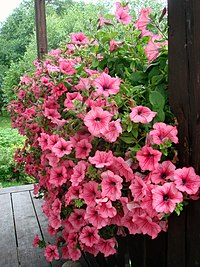
Photo from wikipedia
Abstract An unusual texture with plagioclase phenocrysts clustered as flower-like glomerocrysts has been discovered in the Wulong diorite porphyry at the southern margin of North China Craton. The rock consists… Click to show full abstract
Abstract An unusual texture with plagioclase phenocrysts clustered as flower-like glomerocrysts has been discovered in the Wulong diorite porphyry at the southern margin of North China Craton. The rock consists mainly of plagioclase and amphibole, with the former as dominant phenocryst. Two groups of the plagioclase phenocrysts have been distinguished: flower-like glomerocrysts (FG-type) and single isolated phenocrysts (SP-type). Chemical compositions of both FG- and SP-type plagioclases are similar in anorthite contents (An35–45) which are slightly higher than the matrix (An25–35). Calculation of the plagioclase crystallization time based on Crystal Size Distribution (CSD) program shows that the FG-type crystals have been formed within a longer timescale (226–2782 years) than the SP-type crystals (98–1910 years). The concave down CSDs and lack of small crystals for FG-type plagioclases suggest that coarsening may have been involved. In contrast, a concave-up CSD within the size of 3–10 mm plagioclase, indicating that a rejuvenation kinetic process after coarsening. A possible formation history for the unusual flower-like plagioclase glomerocrysts was proposed as follows. (1) Initial nucleation and growth of single crystals in a confined environment. (2) Ascent of early crystals with magma upwelling and radial coarsening at the roof layer of magma chamber. (3) Remobilization of dense crystal mush and final emplacement at shallow level of crust. (4) Rapid cooling and extensive nucleation and growth of matrix. (5) Post-magmatic alteration and metamorphism. It is likely that the morphologic diversity of plagioclase glomerocrysts are largely influenced by variation of undercooling degrees. The second step is the most important for the formation of the flower-like glomerophyric texture which requires an environments of relatively low undercooling degree.
Journal Title: Lithos
Year Published: 2018
Link to full text (if available)
Share on Social Media: Sign Up to like & get
recommendations!